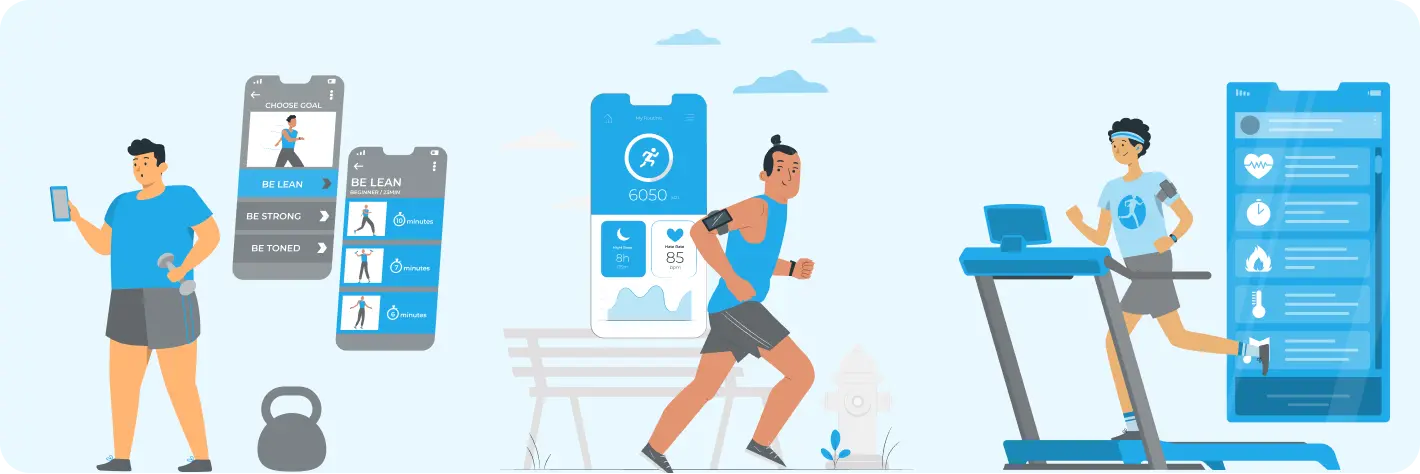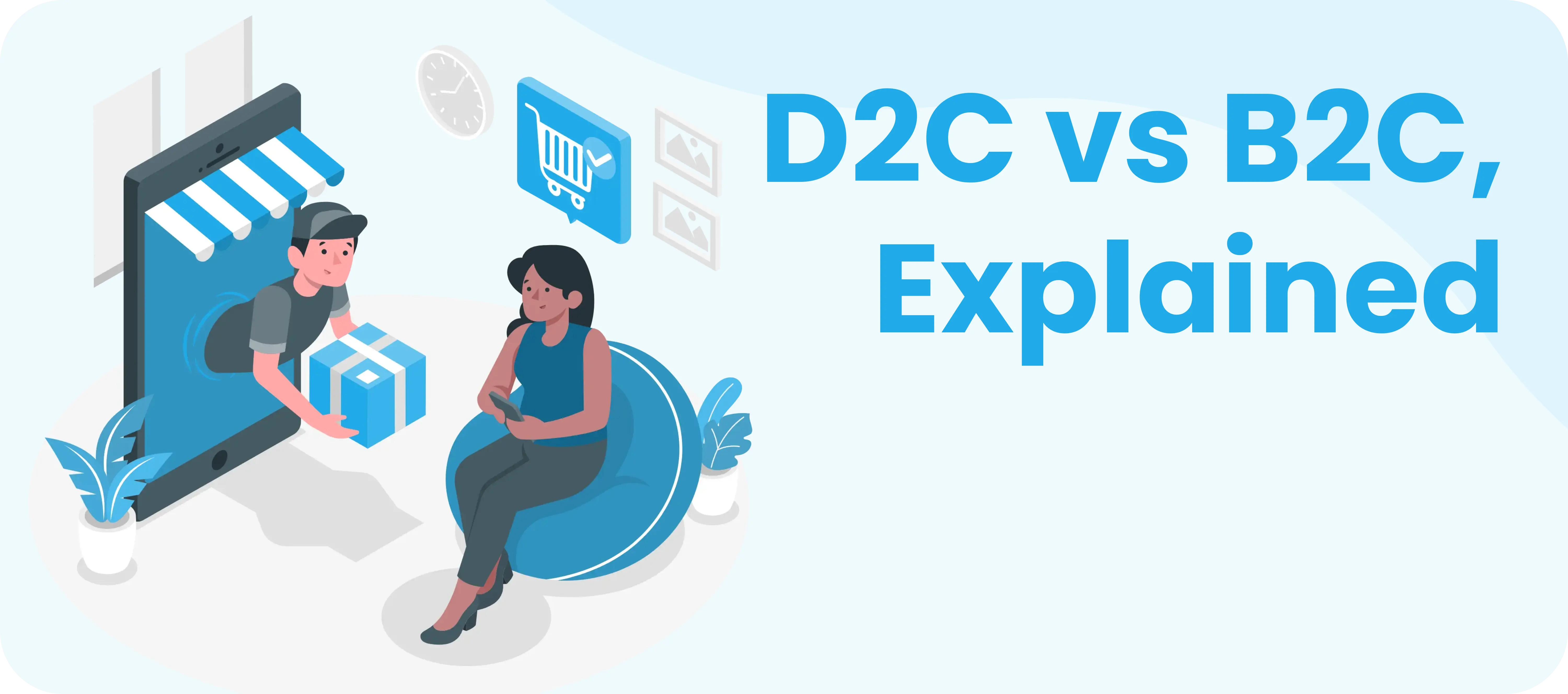How to Build Fitness App like HealthifyMe
Short Description
In this blog post, we examine the crucial components for building successful fitness software in the market of today. We investigate the most recent trends and innovations in fitness that might improve user engagement and offer a tailored fitness experience. We explain how these elements might improve the usefulness and attractiveness of fitness apps, from gamification and virtual reality to harnessing artificial intelligence and machine learning. We also stress the significance of social media integration, audio-guided workouts, and mental health elements. This blog gives helpful insights and helpful suggestions to help you build a successful fitness app that stands out in the crowd, whether you’re a fitness fanatic or a developer trying to enter the fitness app industry.
Introduction
Embarking on a fitness journey has never been easier, thanks to the rise of fitness apps. These digital companions have revolutionized the way we approach health and wellness, providing personalized guidance, tracking tools, and expert advice at our fingertips. Among the leading fitness apps in the market, HealthifyMe stands out as a shining example of success and innovation. In this blog post, we will explore the key aspects of building a fitness app like HealthifyMe and the essential features that drive its popularity.
Fitness App Market Growth

The fitness app market has experienced phenomenal growth in recent years. According to statistics from Allied Market Research 1, the fitness app market size is projected to reach a staggering figure of $15.59 billion by 2026. This remarkable growth can be attributed to the increasing health consciousness among individuals and the growing adoption of smartphones worldwide.
Types of Fitness Apps
When it comes to fitness apps, there is a diverse range of options available to cater to different needs. Let’s take a closer look at some popular categories

Fitness Tracking Apps: Fitness tracking apps are designed to monitor and track your physical activities, providing valuable insights into your fitness progress. They typically utilize sensors in smartphones or wearable devices to track metrics such as steps taken, distance covered, calories burned, and heart rate. These apps often offer goal setting, progress tracking, and motivational features to help users stay on track with their fitness journey.
Personal Training Apps: Personal training apps provide users with access to personalized workout routines and expert guidance. They often feature a library of workout videos or interactive exercise programs led by professional trainers. These apps consider factors such as fitness level, goals, and preferences to tailor the workouts to individual needs. Users can follow along with instructional videos, track their progress, and receive feedback to optimize their training sessions.
Diet and Nutrition Apps: Diet and nutrition apps focus on helping users manage their eating habits and make healthier choices. They provide tools for tracking food intake, counting calories, and monitoring macronutrient and micronutrient consumption. Some apps offer features like barcode scanning to quickly log food items, meal planning options, personalized nutrition recommendations, and even integration with grocery delivery services. These apps aim to educate and empower users to make informed dietary decisions.
Managing Gym Equipment: Managing gym equipment apps assist users in organizing and optimizing their gym workouts. They can include features like workout tracking, weight and rep logging, exercise libraries with proper form demonstrations, and customizable workout plans. These apps help users keep track of their progress, set goals, and maintain a structured gym routine. Some apps also provide social features, allowing users to connect with a community of fitness enthusiasts for support and motivation.
Top Players in Health and Fitness Apps
The health and fitness app market is brimming with exceptional applications. The Forbes Health editorial team has curated a list of the top fitness apps for 2023, and here are a few notable mentions:
Fiton: Fiton is a comprehensive fitness app that offers a wide range of workout routines and exercise programs. It provides users with access to a diverse library of fitness classes, including yoga, HIIT, strength training, and more. Fiton aims to make fitness accessible to everyone by providing workout options suitable for different fitness levels and goals. The app features personalized training plans, video demonstrations, progress tracking, and the ability to connect with fitness enthusiasts worldwide.
BODi by Beachbody: BODi by Beachbody is an all-in-one fitness app that combines workout programs, nutrition plans, and community support. It offers a variety of workout styles, such as dance, cardio, strength training, and mindfulness. BODi provides users with on-demand workout videos led by renowned trainers, ensuring an engaging and effective fitness experience. The app also includes meal-planning features, recipe suggestions, and a supportive community to keep users motivated and accountable.
Nike Training Club: Nike Training Club is a popular fitness app developed by Nike, a well-known sports brand. It offers a vast collection of workout routines designed by professional trainers. The app caters to various fitness levels and goals, providing personalized training plans and guidance. Nike Training Club features video tutorials, audio coaching, and tracking capabilities to monitor progress. It also integrates with Nike’s ecosystem of sports products and wearable devices, enhancing the overall fitness experience.
Burn Fit: Burn.Fit is a dynamic fitness app that focuses on high-intensity workouts and calorie burning. It offers a wide range of intense workout sessions, including circuit training, bodyweight exercises, and cardio workouts. Burn.Fit provides users with real-time tracking of their heart rate, calories burned, and workout duration. The app aims to challenge users and push their limits, helping them achieve their fitness goals efficiently.
MyFitnessPal: MyFitnessPal is a well-established fitness app that combines activity tracking, nutrition tracking, and community support. It allows users to track their daily food intake, count calories, and set personalized nutrition goals. MyFitnessPal features a vast food database, enabling users to easily log their meals and make informed dietary choices. The app also integrates with popular fitness trackers and wearable devices, syncing activity data seamlessly. Additionally, MyFitnessPal offers a supportive community where users can connect, share progress, and gain motivation.
HealthifyMe: Over 10 million people use the well-known health and fitness app HealthifyMe worldwide. It has a number of functions, including interaction with fitness sensors, coaching that is tailored to the user, monitoring of workouts, and nutrition tracking. The app connects users with competent professionals for advice and gives consumers access to a large culinary library. To keep customers engaged, HealthifyMe also provides challenges and a welcoming community. Plans with higher membership prices provide access to further features including personalized meal plans and sophisticated exercise tracking. For individuals looking for a comprehensive approach to health and wellbeing, this app is user-friendly.
We excel in delivering top-notch mobile apps! We are constantly in search of
new ideas,technologies, and methods to fulfill our client’s needs.
What is HealthifyMe App ?
HealthifyMe is a leading fitness app that has gained immense popularity and success. It provides a holistic approach to health and wellness, combining fitness tracking, personalized training, and nutrition guidance. With its user-friendly interface and advanced features, HealthifyMe has emerged as a preferred choice for fitness enthusiasts.
HealthifyMe App’s Current Market Size
HealthifyMe has experienced tremendous growth in recent years. As per the company’s standalone financial statements filed with RoC, the Indian entity of HealthifyMe Wellness Private Limited reported revenue of Rs 185.25 crore in FY22, marking a remarkable 2.15X increase from the previous fiscal year 3.
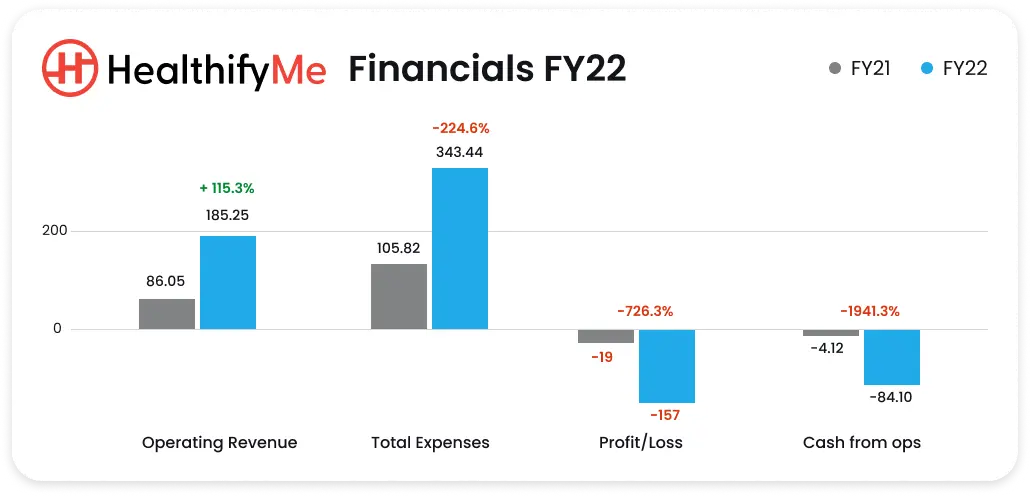
Content & states originally published on Entrackr and has been published here
Features Required to Create Fitness Apps like HealthifyMe
To develop a successful fitness app like HealthifyMe, several key features should be considered. These include:
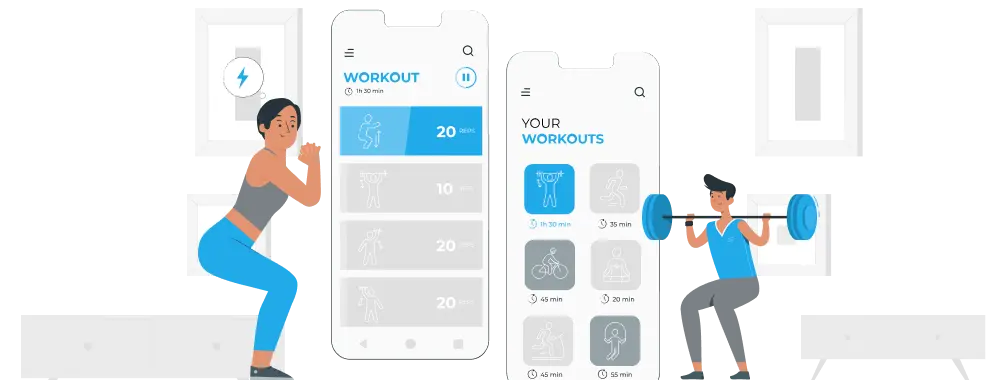
User Registration and Profile Management:Enable users to create accounts, personalize profiles, and set fitness goals. This feature allows for a personalized fitness experience tailored to individual needs.
Activity Tracking: Implement features that track and monitor physical activities, including steps taken, distance covered, calories burned, and heart rate. Accurate activity tracking helps users understand their progress and stay motivated.
Personalized Training Plans: Provide customized workout plans based on user preferences, fitness level, and goals. This feature ensures that users receive tailored exercise routines that align with their specific needs.
Nutrition Tracking and Meal Planning: Incorporate tools for tracking food intake, calorie counting, meal recommendations, and personalized nutrition plans. This feature promotes healthy eating habits and helps users achieve their dietary goals.
Integration with Wearable Devices:Enable seamless synchronization with popular wearable devices, such as fitness trackers and smartwatches. Integrating with wearables allows users to gather accurate data and receive real-time feedback on their fitness activities.
Steps to Build an App Like HealthifyMe
Define Your App’s Purpose and Target Audience: Clearly articulate the purpose of your fitness app and identify the specific target audience it aims to serve. Understanding your app’s niche and target market is crucial for its success.
Conduct Market Research and Identify Competitors: Thoroughly research the fitness app market to identify existing competitors and analyze their features, strengths, and weaknesses. This research will help you identify opportunities for differentiation and innovation.
Plan App Features and Functionality: Create a comprehensive plan for the features and functionality your fitness app will offer. Consider the core features mentioned earlier, along with any unique features that set your app apart from competitors.
Design User Interface and User Experience: Develop an intuitive and visually appealing user interface (UI) that provides a seamless user experience (UX). Ensure that the app’s design is user-friendly, engaging, and aligns with your target audience’s preferences.
Develop the App’s Backend and Frontend: Implement the app’s backend infrastructure, which includes server setup, database management, and data storage. Simultaneously, work on developing the front end, which involves coding the app’s user interface and integrating it with the backend functionality.
Integrate Third-Party APIs and Wearable Device Compatibility: Incorporate third-party APIs for features like payment gateways, social media integration, and location services. Additionally, if you plan to integrate with wearable devices, ensure compatibility and smooth data synchronization.
Perform Rigorous Testing and Debugging: Thoroughly test the app’s functionality, user flows, and performance to identify and fix any bugs or glitches. Testing should cover various devices, operating systems, and scenarios to ensure a robust and error-free app.
Launch the App and Gather User Feedback: Publish the app on the respective app stores and monitor user feedback. Gather insights from user reviews and ratings to identify areas of improvement and refine the app further.
Continuously Update and Enhance the App’s Features: Regularly update your fitness app with new features, improvements, and bug fixes. Stay updated with industry trends and user demands to keep the app relevant and engaging for your users.
Find out how much it will cost to design your fitness app right now!! Get in shape and
reach your goals with our expert guidance.
How Much Does It Cost to Build a Fitness App Like HealthifyMe in 2023?
The cost of building a fitness app like HealthifyMe can vary depending on several factors, including:
App Complexity and Features: The more advanced and sophisticated the features, the higher the development cost. Complex features such as personalized training plans, nutrition tracking, and integration with wearable devices can increase development costs.
Tech Stack: The choice of technology stack, including programming languages, frameworks, and libraries, can impact the development cost. Opting for more popular and robust technologies may result in higher upfront costs.
Design and User Interface: Investing in a visually appealing and intuitive design may require additional design resources and increase the development cost. Customized UI elements and animations can add to the overall cost.
Development Team: The size and expertise of the development team involved in building the app influence the overall cost. Hiring experienced developers and designers may come at a higher price but can contribute to the app’s quality.
It is recommended to consult with app development companies or professionals to get accurate cost estimates based on your specific app requirements and desired features.
Monetization Strategies for Fitness Apps
While building a powerful fitness app is a rewarding endeavor, it’s essential to consider monetization strategies to sustain your app’s growth and generate revenue. Here are some common monetization options for fitness apps:
Freemium Model: Offer a free version of your app with basic features and limited access, and provide premium features or content through in-app purchases or subscription plans. This model allows users to experience the app’s value before deciding to upgrade for additional benefits.
Subscription Model: Offer tiered subscription plans with different levels of access, such as basic, premium, or premium plus. Subscriptions can be monthly, quarterly, or annually, providing users with ongoing access to exclusive features, personalized content, and premium support.
In-App Purchases: Provide users with the option to purchase additional workout plans, specialized programs, or exclusive content within the app. This can include premium workout routines, nutritional guides, or virtual fitness classes.
Ad-Supported Model: Display relevant advertisements within your app and generate revenue through ad impressions or clicks. Ensure that ads are unobtrusive and relevant to maintain a positive user experience.
Partnerships and Sponsorships: Collaborate with fitness brands, supplement companies, or fitness influencers to create sponsored content, promote products, or offer exclusive discounts to your app’s users. This can be a mutually beneficial arrangement, where you receive financial support while providing value to your users.
White Labeling or Licensing: If your fitness app has unique features or technology, you can explore opportunities to license or white label your app to other fitness businesses or organizations. This allows them to leverage your app’s capabilities while generating revenue for your app.
It’s important to select a monetization strategy that aligns with your app’s value proposition, target audience, and market dynamics. Consider the pricing strategy, competitive landscape, and user preferences when determining the most suitable approach for your fitness app.
The Future of Fitness Apps
As technology continues to advance, fitness apps are poised to play an even more significant role in our health and wellness journeys. Here are some trends and innovations that may shape the future of fitness apps:
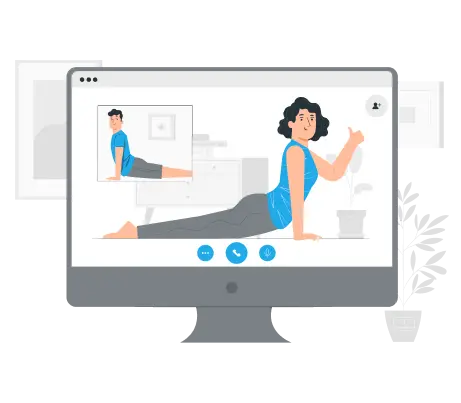
Integration of Artificial Intelligence (AI) and Machine Learning (ML): AI and ML algorithms can analyze user data, provide personalized recommendations, and adapt workout plans based on individual progress and preferences.
Virtual Reality (VR) and Augmented Reality (AR): VR and AR technologies have the potential to transform the fitness experience by creating immersive workout environments, offering virtual coaching, and enhancing user engagement.
Smart Home Integration: Fitness apps may integrate with smart home devices, enabling seamless control of connected fitness equipment, personalized workouts, and real-time tracking of performance metrics.
Health Data Interoperability: Integration with electronic health records and health monitoring devices can provide a holistic view of an individual’s health, enabling personalized fitness recommendations and tailored workout plans.
Gamification and Social Connectivity: Further advancements in gamification techniques and social features will continue to drive user engagement, motivation, and community building within fitness apps.
Remote and Virtual Fitness: The rise of remote and virtual fitness classes opens up opportunities for fitness apps to offer live streaming workouts, interactive training sessions, and virtual coaching from anywhere in the world.
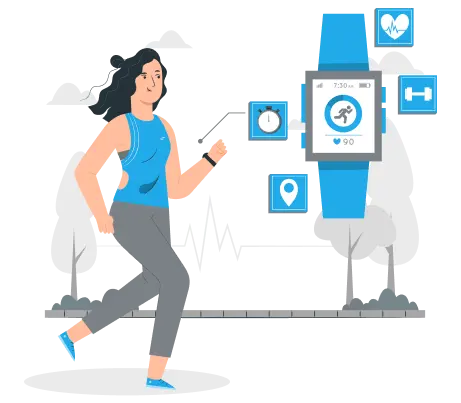
As technology evolves and user expectations change, embracing these trends and incorporating innovative features into your fitness app can help you stay ahead of the competition and deliver exceptional value to your users.
Conclusion
In a fast-paced world, fitness apps like HealthifyMe provide the necessary tools and guidance to lead a healthy lifestyle. By understanding market trends, studying successful apps, and carefully planning the development process, you can create a fitness app that inspires and empowers users to achieve their fitness goals. Embrace the power of technology and embark on your journey to build a fitness app like HealthifyMe.
Willing to transform your fitness app idea into reality? Hire a dedicated developer
today and make it happen!!
Key Learnings
- To succeed in the fitness app market, stay updated with emerging trends and technologies.
- Incorporate gamification elements, virtual reality, and augmented reality to make fitness more engaging.
- Leverage AI and ML algorithms to provide personalized recommendations and accurate fitness tracking.
- Offer audio-guided workouts for convenient and focused exercise sessions.
- Integrate with popular health platforms and devices for a seamless user experience.
- Provide live streaming and on-demand fitness classes to offer a variety of workout options.
- Include features that promote mental well-being, such as guided meditation and stress reduction techniques.
- Personalize content based on user preferences, goals, and historical data.
- Enable social media integration to encourage user engagement and attract new users.
- Ensure accessibility and inclusivity in your app to cater to diverse populations.
FAQ (Frequently Asked Questions)

Q1. What are some emerging technologies to consider for fitness apps?
Emerging technologies for fitness apps include gamification, virtual reality, augmented reality, artificial intelligence, and machine learning.

Q2. How can gamification be implemented in fitness apps?
Gamification in fitness apps can be implemented through challenges, achievement badges, leaderboards, and reward systems that motivate users and foster healthy competition.

Q3. How can AI and ML enhance fitness app experiences?
AI and ML algorithms can analyze user data, provide personalized recommendations, create adaptive workout plans, suggest modifications, and predict user preferences for an enhanced fitness app experience.

Q4. Why is an audio-guided workout important?
Audio-guided workouts provide real-time instructions and motivation, allowing users to focus on their workouts while receiving guidance through their headphones, making it convenient for both indoor and outdoor exercises.

Q5. How can social media integration benefit fitness apps?
Social media integration enables users to share their achievements, progress, and workout summaries, which encourages user engagement and can attract new users through social media exposure.

Q6. Why is accessibility and inclusivity important for fitness apps?
Ensuring accessibility and inclusivity in fitness apps allows individuals with disabilities to access and benefit from the app, while offering modifications and alternative workout options caters to diverse populations.

Q7. What should be the focus beyond physical fitness in fitness apps?
Fitness apps can focus beyond physical fitness by incorporating features that promote mental well-being, such as guided meditation sessions, stress reduction techniques, and sleep tracking.
